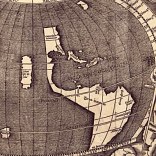|
|
 |
 |
Reading Guide
 |
1.
 |
First Impressions
|
 |
 western hemisphere, detail of Universalis cosmographia, 1507 |
First impressions are said to be lasting impressions, and indeed, it is remarkable how soon the New World "that was never before known to anyone" was viewed as a land of wealth, promise, and opportunity. So we begin with three of the earliest European explorers to North America (after the Norse whose settlements in Greenland died out in the 1300s) and the impressions conveyed to their monarchs, financiers, and soon, due to the printing press, the peoples of Europe:
- CHRISTOPHER COLUMBUS (Cristoforo Colombo), an Italian sailing for Spain, who explored the Caribbean islands in four voyages from 1492 to 1504, and who insisted to the end that he had landed in or near Asia
[Columbus, Letter to Luis de Sant Angel, Treasurer of Aragon, 1493]
- JOHN CABOT (Giovanni Caboto), an Italian sailing for England, who in 1497 explored the northeast coast of North America in the region of Newfoundland, and was certain he had reached northeast Asia
[Letter from Lorenzo Pasqualigo to his brothers, August 1497; Raimondo di Soncino to the Duke of Milan, first and second despatches, 1497]
- GASPAR CORTE REAL, a Portuguese sailing for Portugal, who explored the same region as Cabot in 1500 and 1501, failing to find a northwest passage and losing his life in the search.
[Pietro Pasqualigo, Letter to his brothers, 1501]
All three expeditions were financed by European monarchs to find a westward route to Asia or, later, to find a route around the obtrusive land mass to reach Asia. All claimed land and future riches for their monarchs. All returned with artifacts of the new land, and two returned with captured Indians. For Columbus we have the explorer's first-hand reports, but for Cabot and Corte Real we rely on second-hand accounts, the only documentation that survives. The three maps reveal how the western hemisphere evolved visually in the European mind, reflecting fact and faith alike. Explore these documents for the Europeans' first impressions, and yours. (10 pages, excluding the maps that are best viewed online.)
Discussion questions
- Overall, what are the Europeans' first impressions of the new lands and their inhabitants?
- What do they find important to relate in their reports?
- How do the native inhabitants respond to the explorers? How do the Europeans interpret these responses?
- How does each document address its intended audience?
- What evidence is presented for the explorers' having reached Asia?
- What goals do the Europeans stress for further expeditions?
- What do you find predictable or surprising in the reports?
- What does your response to question #7 indicate about evaluating documents of another age?
|
 |
 |
Topic Framing Questions
| • |
How did Europeans interpret the "newe fonde londe" upon their first contacts? |
| • |
How did Indians respond to the Europeans? |
| • |
How did these initial encounters frame future Indian-European relationships? |
| • |
What did the "New World" signify to Europe in 1500? in 1550?
|
|
|
 |
 |
| *PDF file - You will need software on your computer that allows you to read and print Portable Document Format (PDF) files, such as Adobe Acrobat Reader. If you do not have this software, you may download it FREE from Adobe's Web site. |
|
Columbus: | National Humanities Center |
| Cabot: | Internet Modern History Sourcebook, Paul Halsell, ed., Fordham University |
| Corte Real: | National Humanities Center |
| Maps: |
Universalis cosmographia: Library of Congress, Geography & Maps Division
Die neuwe Islelen and Charte cosmographique: University of Alabama, Dept. of Geography
|

Image: Martin Waldseemüller, map of the world, Universalis cosmographia secundum Ptholomaei traditionem et Americi Vespucii alioru[m]que lustrationes, 1507, detail. Courtesy Library of Congress, Geography & Map Division.
|
|
|
 |
